Fortunately,the young roo’s paws were bandaged by then – his “big clown feet” burnt but likely to heal,said Zabinskas OAM. Also fortunately,he added,“the kick wasn’t any lower.”
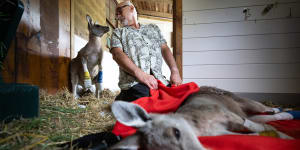
Alfred the roo checking on Manfred Zabinskas OAM as he cares for an older roo.Jason South
It turns out the lucky animal already had a name:Alfred. “The landowner where he was found knows him. He later called in a mum and a joey too,and,you know what? The roos all know each other too,” Zabinskas said. “They’re the same mob. So Alfred’s settled right down,they’re sleeping cuddled together now.”
On Thursday,a week after started roaring through western Victoria,the state mobilised its wildlife emergency network of volunteer rescuers and vets. They’re now in the field,trained to work alongside fire crews,assessing animals,and rescuing those they can.
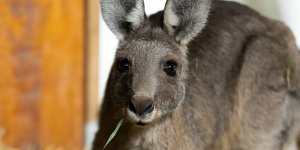
Alfred the kangaroo after being rescued following the devastating fires near Beaufort.Jason South
While firefighters have had,staving off the blaze from and other towns,the fire has. That’s home to koalas,echidnas,wallabies,and more,and wildlife experts fear some populations won’t recover.
Concern is particularly high for a small population of koalas near Beaufort.
Experienced local carer Esther Hands took in two burnt koalas last week – both found near where the blaze began.
“That’s a high number,and we’ve never even seen koalas in that area before,” she said. “We know there’s a little population in Mount Cole. We’re worried this will wipe them out.”
One koala died in her arms within hours. The other,a younger male who “looked perfect on the outside apart from his burnt paws”,was rushed to vets at Werribee Zoo. “But sadly,there was more internal injury than we thought,” Hands said.
Retired wildlife biologist Dr Kath Handasyde said koalas often fared badly in bushfires,inhaling smoke high in the treetops;too big to fit down many shelters but too slow to escape.

Yet many animals will be badly impacted by this fire,she added,including,potentially,even rarer species.
Hands said she is now bracing for an influx of injured wildlife. “It’s usually in the days and weeks after,they come out desperate for food,or people return to their homes and find them.”
Now that the fire threat has eased for humans,it’s crunch time for wildlife teams. “And this is looking like a bad one for animals,” Zabinskas said.
One of the few rescuers trained in dart-gun tranquillising,he’s charged into fire grounds,abseiled down mine shafts to save kangaroos,and in,2007,helped lead one of the largest wildlife rescues in Australia’s history:when some 400 koalas were saved from that.
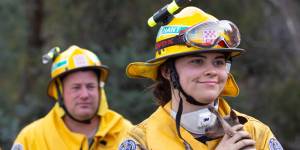
CFA firefighters rescuing a joey from a fire in Mount Lonarch on Wednesday,which later passed away.CFA
But this time,he’s sitting out the deployment call to care for burns victims streaming into his shelter further east in Trentham. As he spoke toThe Age,a Wildlife Victoria vet was treating Alfred’s burns.
The wildlife emergency network,coordinated with Zoos Victoria,was brought in after the saw many volunteer of across the country,despite previous protocol allowing them in when safe.
“We’re hoping this network will be better,” said Zabinskas,who was himself a senior firefighter with the CFA for 15 years.
Even milder injuries such as burnt paws can become infected if not treated. “But there’s a lot we can do for animals if we can get in,” he said.
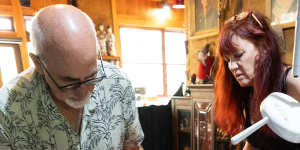
Helen Round and Manfred Zabinskas OAM changing the bandages of an injured female kangaroo at their home wildlife shelter in Trentham.Jason South
“Of course,it’s hard when the fire’s raging. So it has to be about[human] safety first. Everyone’s got to be trained. And the way the,we couldn’t get in as early as we’d like.”
The state environment department,which runs wildlife responses in bushfires,said its own wildlife assessment teams had been in the field searching since February 16.
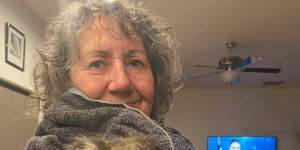
Beaufort wildlife carer Esther Hands with a juvenile male koala rescued from fires she took to Werribee Zoo.Esther Hands
Human life and property are prioritised by fire crews,and,when it’s safe to allow them in,vets and rescuers work under their close direction.
It’s usually sad work,euthanising animals too far gone for rehabilitation. “You want to get in there and end their suffering as soon as you can,” Zabinskas said.
But those that are taken back to shelters have high success rates. “Because we’ve learned what’s saveable and what’s not.”
And sometimes,even then,animals still surprise their rescuers.
Zabinskas recalls finding a badly burnt koala cradling her baby after Victoria’s Stoneyford fires in 2006.
“She was just scorched but she’d wrapped herself around her bub so the little one wasn’t even singed,” he said.
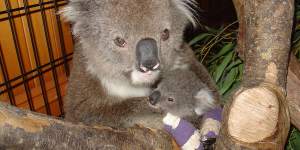
Koala mother Elsa was badly burned protecting her joey Sunshine after the 2006 Stoneyford fires in Victoria but both were saved and released back into the wild.Manfred Zabinskas
“And you know what? They both survived somehow.
“That mum had such a will to live for her baby. We released them back into the wild. That’s why you keep going out there.”
As the smoke clears from these latest fires,Hands is urging people to put out water and food such as hay for wildlife in affected areas where safe,and to notify carers,,or if they find an injured animal.
“Sometimes miracles really do happen.”
Get the day’s breaking news,entertainment ideas and a long read to enjoy.